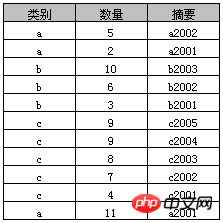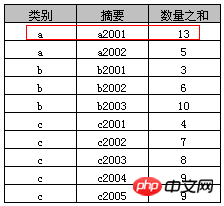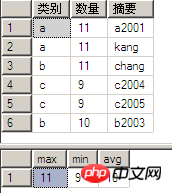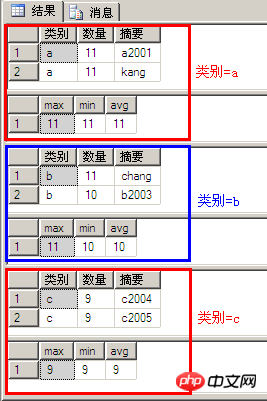 Database
Database
 Mysql Tutorial
Mysql Tutorial
 The system organizes the usage of Group By in SQL and the restrictions on multiple fields of Group By
The system organizes the usage of Group By in SQL and the restrictions on multiple fields of Group By
The system organizes the usage of Group By in SQL and the restrictions on multiple fields of Group By
When to use Group By in SQL? This article explains in detail the usage of Group By. Its simple definition is to divide a "data set" into several "small areas", and then perform data processing on several "small areas". What are the restrictions on the fields specified by Select in Group By? apache php mysql
1. Overview
"Group By" literally means to group data according to the rules specified by "By". The so-called grouping is to group a "data set" Divide it into several "small areas", and then perform data processing on several "small areas".
2. Original table

3. Simple Group By
Example 1
select 类别, sum(数量) as 数量之和 from A group by 类别
The return result is as follows, In fact, it is a summary.

4, Group By and Order By
Example 2
select 类别, sum(数量) AS 数量之和 from A group by 类别 order by sum(数量) desc
The return results are as follows

"order by sum of quantities desc" cannot be used in Access, but it can be used in SQL Server.
5. Field restrictions specified by Select in Group By
Example 3
select 类别, sum(数量) as 数量之和, 摘要 from A group by 类别 order by 类别 desc
After executing Example 3, an error will be prompted, as shown below. This is what needs to be noted. The fields specified in select must either be included after the Group By statement as the basis for grouping; or they must be included in the aggregate function.

6、Group By All
Example 4
select 类别, 摘要, sum(数量) as 数量之和 from A group by all 类别, 摘要
In Example 4, you can specify the "Summary" field because " "Multi-column grouping" contains "summary fields", and the execution results are as follows Group the values. In Example 4, you can see that "a, a2001, 13" is the merger of the two records "a, a2001, 11" and "a, a2001, 2".
Although "group by all" is supported in SQL Server, GROUP BY ALL will be deleted in future versions of Microsoft SQL Server to avoid using GROUP BY ALL in new development work. Access does not support "Group By All", but Access also supports multi-column grouping. The above SQL in SQL Server can be written in Access as 
select 类别, 摘要, sum(数量) AS 数量之和 from A group by 类别, 摘要
Function
| sum(column name) | ||
|---|---|---|
| max(column name) | Maximum value | |
| min(column name) | minimum value | |
| avg(column name) | average Value | |
| ##first(column name) | First record | |
| last(column name) | Last record | |
| count(column name) | Statistical record number | |
示例5:求各组平均值 select 类别, avg(数量) AS 平均值 from A group by 类别; Copy after login 示例6:求各组记录数目 select 类别, count(*) AS 记录数 from A group by 类别; Copy after login 示例7:求各组记录数目 8、Having与Where的区别
示例8 select 类别, sum(数量) as 数量之和 from A group by 类别 having sum(数量) > 18 Copy after login 示例9:Having和Where的联合使用方法 select 类别, SUM(数量)from A where 数量 gt;8 group by 类别 having SUM(数量) gt; 10 Copy after login 9、Compute 和 Compute Byselect * from A where 数量 > 8 Copy after login 执行结果:
示例10:Compute select * from A where 数量>8 compute max(数量),min(数量),avg(数量) Copy after login 执行结果如下:
compute子句能够观察“查询结果”的数据细节或统计各列数据(如例10中max、min和avg),返回结果由select列表和compute统计结果组成。 示例11:Compute By select * from A where 数量>8 order by 类别 compute max(数量),min(数量),avg(数量) by 类别 Copy after login 执行结果如下:
示例11与示例10相比多了“order by 类别”和“... by 类别”,示例10的执行结果实际是按照分组(a、b、c)进行了显示,每组都是由改组数据列表和改组数统计结果组成,另外:
在实际开发中compute与compute by的作用并不是很大,SQL Server支持compute和compute by,而Access并不支持 相关文章: 相关视频: The above is the detailed content of The system organizes the usage of Group By in SQL and the restrictions on multiple fields of Group By. For more information, please follow other related articles on the PHP Chinese website! Statement of this Website
The content of this article is voluntarily contributed by netizens, and the copyright belongs to the original author. This site does not assume corresponding legal responsibility. If you find any content suspected of plagiarism or infringement, please contact admin@php.cn

Hot AI Tools
Undresser.AI UndressAI-powered app for creating realistic nude photos 
AI Clothes RemoverOnline AI tool for removing clothes from photos. 
Undress AI ToolUndress images for free 
Clothoff.ioAI clothes remover 
Video Face SwapSwap faces in any video effortlessly with our completely free AI face swap tool! 
Hot Article
Assassin's Creed Shadows: Seashell Riddle Solution
4 weeks ago
By DDD
What's New in Windows 11 KB5054979 & How to Fix Update Issues
3 weeks ago
By DDD
Where to find the Crane Control Keycard in Atomfall
4 weeks ago
By DDD
Roblox: Dead Rails - How To Complete Every Challenge
1 months ago
By DDD
How to fix KB5055523 fails to install in Windows 11?
2 weeks ago
By DDD

Hot Tools
Notepad++7.3.1Easy-to-use and free code editor 
SublimeText3 Chinese versionChinese version, very easy to use 
Zend Studio 13.0.1Powerful PHP integrated development environment 
Dreamweaver CS6Visual web development tools 
SublimeText3 Mac versionGod-level code editing software (SublimeText3) 
Hot Topics When might a full table scan be faster than using an index in MySQL?
Apr 09, 2025 am 12:05 AM
When might a full table scan be faster than using an index in MySQL?
Apr 09, 2025 am 12:05 AM
Full table scanning may be faster in MySQL than using indexes. Specific cases include: 1) the data volume is small; 2) when the query returns a large amount of data; 3) when the index column is not highly selective; 4) when the complex query. By analyzing query plans, optimizing indexes, avoiding over-index and regularly maintaining tables, you can make the best choices in practical applications.  Explain InnoDB Full-Text Search capabilities.
Apr 02, 2025 pm 06:09 PM
Explain InnoDB Full-Text Search capabilities.
Apr 02, 2025 pm 06:09 PM
InnoDB's full-text search capabilities are very powerful, which can significantly improve database query efficiency and ability to process large amounts of text data. 1) InnoDB implements full-text search through inverted indexing, supporting basic and advanced search queries. 2) Use MATCH and AGAINST keywords to search, support Boolean mode and phrase search. 3) Optimization methods include using word segmentation technology, periodic rebuilding of indexes and adjusting cache size to improve performance and accuracy.  Can I install mysql on Windows 7
Apr 08, 2025 pm 03:21 PM
Can I install mysql on Windows 7
Apr 08, 2025 pm 03:21 PM
Yes, MySQL can be installed on Windows 7, and although Microsoft has stopped supporting Windows 7, MySQL is still compatible with it. However, the following points should be noted during the installation process: Download the MySQL installer for Windows. Select the appropriate version of MySQL (community or enterprise). Select the appropriate installation directory and character set during the installation process. Set the root user password and keep it properly. Connect to the database for testing. Note the compatibility and security issues on Windows 7, and it is recommended to upgrade to a supported operating system.  Difference between clustered index and non-clustered index (secondary index) in InnoDB.
Apr 02, 2025 pm 06:25 PM
Difference between clustered index and non-clustered index (secondary index) in InnoDB.
Apr 02, 2025 pm 06:25 PM
The difference between clustered index and non-clustered index is: 1. Clustered index stores data rows in the index structure, which is suitable for querying by primary key and range. 2. The non-clustered index stores index key values and pointers to data rows, and is suitable for non-primary key column queries.  MySQL: Simple Concepts for Easy Learning
Apr 10, 2025 am 09:29 AM
MySQL: Simple Concepts for Easy Learning
Apr 10, 2025 am 09:29 AM
MySQL is an open source relational database management system. 1) Create database and tables: Use the CREATEDATABASE and CREATETABLE commands. 2) Basic operations: INSERT, UPDATE, DELETE and SELECT. 3) Advanced operations: JOIN, subquery and transaction processing. 4) Debugging skills: Check syntax, data type and permissions. 5) Optimization suggestions: Use indexes, avoid SELECT* and use transactions.  Explain different types of MySQL indexes (B-Tree, Hash, Full-text, Spatial).
Apr 02, 2025 pm 07:05 PM
Explain different types of MySQL indexes (B-Tree, Hash, Full-text, Spatial).
Apr 02, 2025 pm 07:05 PM
MySQL supports four index types: B-Tree, Hash, Full-text, and Spatial. 1.B-Tree index is suitable for equal value search, range query and sorting. 2. Hash index is suitable for equal value searches, but does not support range query and sorting. 3. Full-text index is used for full-text search and is suitable for processing large amounts of text data. 4. Spatial index is used for geospatial data query and is suitable for GIS applications.  The relationship between mysql user and database
Apr 08, 2025 pm 07:15 PM
The relationship between mysql user and database
Apr 08, 2025 pm 07:15 PM
In MySQL database, the relationship between the user and the database is defined by permissions and tables. The user has a username and password to access the database. Permissions are granted through the GRANT command, while the table is created by the CREATE TABLE command. To establish a relationship between a user and a database, you need to create a database, create a user, and then grant permissions.  Can mysql and mariadb coexist
Apr 08, 2025 pm 02:27 PM
Can mysql and mariadb coexist
Apr 08, 2025 pm 02:27 PM
MySQL and MariaDB can coexist, but need to be configured with caution. The key is to allocate different port numbers and data directories to each database, and adjust parameters such as memory allocation and cache size. Connection pooling, application configuration, and version differences also need to be considered and need to be carefully tested and planned to avoid pitfalls. Running two databases simultaneously can cause performance problems in situations where resources are limited. 
|







